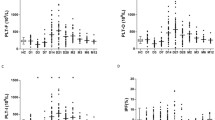Abstract
Objective
To assess in patients with multiple trauma the relevance of the following as predictive markers for infections: the inflammation parameters white blood count, body temperature, blood polymorphonuclear leukocyte (PMN) migration; blood levels of C-reactive protein, PMN elastase, procalcitonin, neopterin, interleukin 6, interleukin 8, malondialdehyde, total antioxidative status; the stress parameters cortisol and lactate.
Design
Prospective observational cohort study.
Setting
Intensive Care Unit of a university surgical department.
Patients
Twenty-six patients with multiple trauma of differing severity.
Measurements and results
Trauma severity was estimated by the ISS. PMN migration upon F-Met-Leu-Phe stimulation was determined in fresh whole blood in a ready-for-use, one-way membrane filter assay and evaluated by automated image analysis. The other parameters were measured with commercially available tests. During hospitalization, nine patients developed infections, and 17 patients were free of infection. PMN migration below a critical minimum preceded infections in eight of the infected, but occurred in only three of the non-infected patients (positive/negative predictive values 0.72/0.93; sensitivity/specificity 0.88/0.82; likelihood ratio 5.0). Fever (≥38.0 °C) had predictive values of 0.83/0.80 and a high likelihood ratio of 9.4, but a low sensitivity/specificity of 0.55/0.94. The other parameters were without significance. Procalcitonin, elastase, C-reactive protein, neopterin and lactate correlated positively with the injury severity score.
Conclusion
PMN migration proved to be a highly sensitive predictive marker for infections. The whole-blood PMN migration test may facilitate early aggressive antimicrobial therapy.
Similar content being viewed by others
References
Kreger BE, Craven DE, McCabe WR (1980) Gram-negative bacteremia. IV. Re-evaluation of clinical features and treatment in 612 patients. Am J Med 68:344–355
Bone RC, Fisher CJ, Clemmer TP, Slotman, GJ, Metz, CA, Balk, RA (1989) Sepsis syndrome: a valid clinical entity. Crit Care Med 17:389–393
Papia G, McLellan BA, El-Helou P, Louie M, Rachlis A, Szalai JP Simor AE (1999) Infection in hospitalized trauma patients: incidence, risk factors, and complications. J Trauma 47:923–927
Egger G, Aglas F, Rainer F (1995) Blood polymorphonuclear leukocyte migratory activities during rheumatoid arthritis. Inflammation 19:651–667
Aglas F, Hermann J, Egger G (1998) Abnormal directed migration of blood polymorphonuclear leukocytes in rheumatoid arthritis. Potential role in increased susceptibility to bacterial infections. Mediators Inflamm 7:19–23
Egger G, Burda A, Hengster P, Kunc M, Margreiter R (2000) Polymorphonuclear leukocyte functions as predictive markers for infections after organ transplantation. Transplant Int 13: 114–121
Glasner A, Egger G, Winter R (2001) Impaired whole-blood polymorphonuclear leukocyte migration as a possible predictive marker for infections in premature preterm rupture of membranes. Infect Dis Obstet Gynecol 9:227–232
Egger G, Burda A, Mitterhammer H, Baumann G, Bratschitsch G, Glasner A (2003) Impaired blood polymorphonuclear leukocyte migration and infection risk in severe trauma. J Infect 47:148–154
Muckard DJ, Bhagwanjee S (1997) American College of Chest Physicians/Society of Critical Care Medicine Consensus Conference definitions of the systemic inflammatory response syndrome and allied disorders in relation to critically injured patients. Crit Care Med 25:1789–1795
Egger G, Kukovetz EM, Hayn M, Fabjan JS (1997) Changes in the polymorphonuclear leukocyte function of blood samples induced by storage time, temperature and agitation. J Immunol Methods 206:61–71
Egger G, Klemt CH, Spendel S, Kaulfersch W, Kenzian H (1994) Migratory activity of blood polymorphonuclear leukocytes during juvenile rheumatoid arthritis, demonstrated with a new whole-blood membrane filter assay. Inflammation 18:427–441
Stephan F, Yang K, Tankovic J, Soussy CJ, Dhonneur G, Duvaldestin P, Brochard L, Brun-Buisson C, Harf A, Delclaux C (2002) Impairment of polymorphonuclear neutrophil functions precedes nosocomial infections in critically ill patients. Crit Care Med 30:315–322
Author information
Authors and Affiliations
Corresponding author
Additional information
Coauthors are listed in alphabetical order
Rights and permissions
About this article
Cite this article
Egger, G., Aigner, R., Glasner, A. et al. Blood polymorphonuclear leukocyte migration as a predictive marker for infections in severe trauma: comparison with various inflammation parameters. Intensive Care Med 30, 331–334 (2004). https://doi.org/10.1007/s00134-003-2111-6
Received:
Accepted:
Published:
Issue Date:
DOI: https://doi.org/10.1007/s00134-003-2111-6




